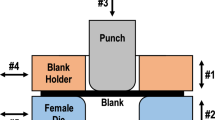Abstract
The effects of specimen width and blankholder (clamp) force on LDH were investigated in tests with bare DDQ SK steel strip. Specimen width ranged from 109 to 143 mm (4.29 to 5.63 in.). The die set comprised a ball-bearing ball punch of 101.6 mm (4 in.) diameter and blankholders with a triangular clamping bead. Clamp forces ranged from 100 to 500 kN (11.25 to 56 tons). Draw-in, critical blank width, and LDH diminished with increasing clamp force, and draw-in and LDH reached their minimum at forces of 250 kN (28 tons) and above. The results showed that if an insufficient clamp force or a blank of excessive width is used, the LDH value will be above its true (minimum) value.
Similar content being viewed by others
References
North American Deep Drawing Research Group, Recommended Referee Practice for the Limiting Dome Height (LDH) Test.
J.A. Schey, “Surface Preparation for the LDH Test,”J. Mater. Shaping Techn., 1988, vol. 6, pp. 103–111.
B. Taylor, “Sheet Formability Testing” inMetals Handbook, 9th ed., Vol. 8,Mechanical Testing, American Society for Metals, Metals Park, Ohio, 1985, p. 562.
Author information
Authors and Affiliations
Rights and permissions
About this article
Cite this article
Schey, J.A., Fischer, R.F. Effects of clamp force in Limiting Dome Height (LDH) Test. J. Materials Shaping Technology 9, 85–88 (1991). https://doi.org/10.1007/BF02833638
Issue Date:
DOI: https://doi.org/10.1007/BF02833638



